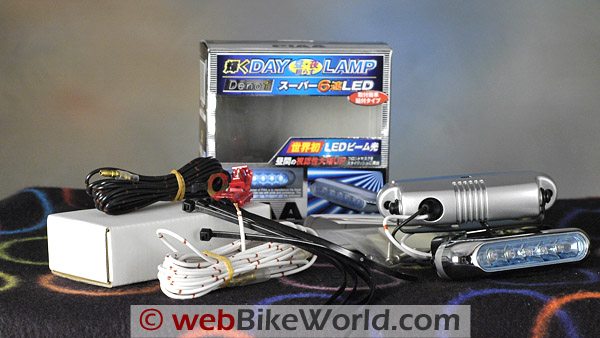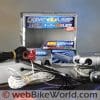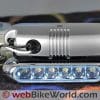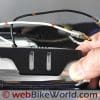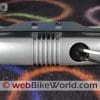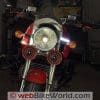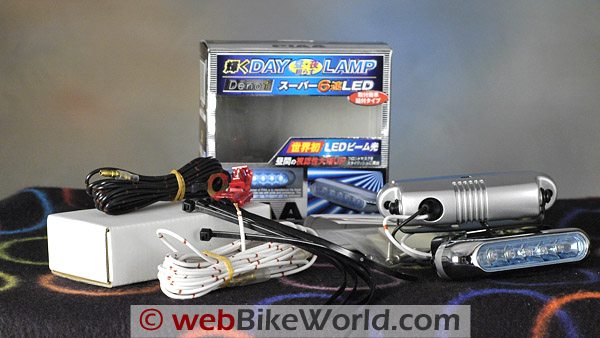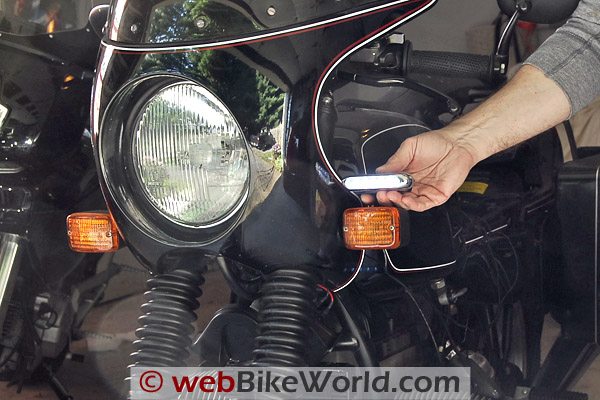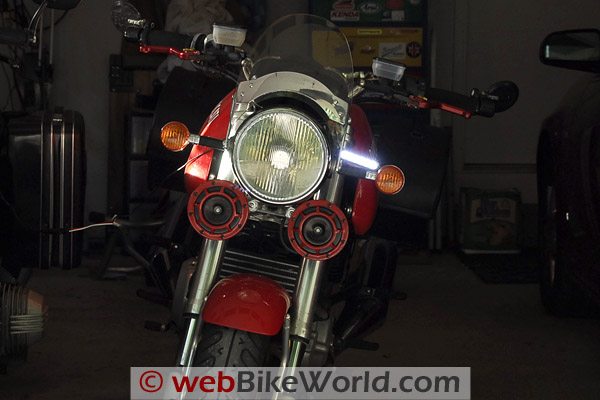I feel kind of silly writing about a product that I couldn’t really find a use for.
But, you never know — I’m sure some webBikeWorlders will be interested, and one of you must surely can figure out how to put these to good use?
I found these PIAA LED driving (running) lights, or “Day Lamps”, as they’re called, while searching for additional lighting for the front of a motorcycle.
These lights aren’t designed specifically for motorcycles, but they are designed to improve visibility — something like a daytime running light. They do not throw enough light to enhance the bike’s headlight in any way.
My assumption, which was based on an article I read somewhere that said something to the effect that the depth perception of a driver of a car or motorcycle driver can be affected by the width of the oncoming vehicle.
The premise is that a narrow oncoming object like a motorcycle may seem farther away than it really is because the width of the oncoming object has an effect on depth perception.
The article claimed that this might be the cause of many car/motorcycle accidents, where the car turns left in front of a motorcycle or pulls out of a driveway in front of a motorcycle because they either didn’t see the bike or misjudged its speed and/or distance.
If this is true, then it’s possible that increasing the perceived width of the front of a motorcycle might provide other vehicles with a more realistic assessment of the location, distance and speed of the moving (oncoming) bike.
Unfortunately, I can’t find a reference to the exact story or research article, and other scientific research that I’ve found sort of touches the edges of this theory, but I haven’t found other research on the subject of the size of an oncoming vehicle vs. depth or distance perception.
If any of our readers can direct us to information or studies on this topic, please let me know.
In the absence of any research that demonstrates that a particular technology makes a motorcycle more visible, we’re sort of just guessing, are we not? So products like headlight modulators, blinking LED brake lights, etc. may seem to work, but show me the proof!
Actually, I’m not so sure that some of the guesses may do more harm than good.
For example, we’re proponents of the “one bulb, one job” rule. That is, don’t let a bulb do more than one job, like being both a brake light and a tail light, or combining a turn signal with a running light.
My gut instinct tells me this is a bad idea — drivers in other vehicles need to know exactly what it means when a single bulb comes on — not “Is that a turn signal? Isn’t that a running light? That light was glowing steady, now it’s blinking…”
Now of course other drivers may not (or maybe they do) go through all that thinking specifically.
But I’m afraid that while the dude is talking to his girlfriend on the cell phone with the other hand on the wheel in the clapped-out ’87 Camaro, his pea-sized brain may be processing that data right up to the time he slams into me.
So the rule is: one bulb, one job.
And there’s another problem: like many motorcycle owners, I was a proponent of headlight modulators. webBikeWorld has reviewed a couple of them.
Then the manufacturers started recommending that they should be installed on the high beam rather than low.
But a high beam dazzles the oncoming traffic — I don’t need a scientific study to tell me that, I can see it with my own eyes when I’m in a car and a motorcycle with the high beam on comes at me.
So one of two things happens: either the driver doesn’t see the turn signals that are blinking on the bike because the high beam light is too dazzling, overpowering everything, or the high beam attracts the driver’s attention and he/she is looking at it rather than at what the motorcycle is doing.
Double that when the high beam is modulating.
My experience from seeing this on motorcycles as I’m driving or riding towards them is that a high beam is too overpowering for an oncoming driver.
They’re not used to seeing a high beam searing their eyes in broad daylight, especially while it’s modulated.
PIAA LED Conspicuity Lights
Which brings me to these PIAA LED conspicuity lights. Several of us associated with webBikeWorld are using yellow headlight bulbs (see this article) on low beam as our primary source of distinguishing illumination.
The low beam gives the bike visibility to oncoming traffic without blinding them.
But because so many cars are using Daylight Running Lights (DRL), we feel that the yellow bulb distinguishes us a bit from the crowd.
Again, no data on this, just pure subjectivity. I personally do not use a modulator because I feel that oncoming traffic will be looking at the modulated headlight rather than me and the bike and watching what I’m doing (e.g., making a turn, accelerating towards them, etc.).
That’s my personal preference, and I’m sure there are others who will disagree.
I have read a Motorcycle Safety Foundation paper that described a test done under controlled conditions that showed that there was very little to no statistically significant difference in the time (and distance, I think) that it took volunteers to distinguish a motorcycle with low beams, running lights and headlight modulators.
Anyone know the paper I’m talking about? Data! I need data!!
I have noticed during my personal observations that Harley-Davidsons and other cruisers that are equipped with a light bar and running lights on either side of the headlight are more noticeable to me and I can judge their distance and speed more accurately. Once again, purely subjective.
All of this has put me on a mission to find a lighting source that is bright without being dazzling and that I can install on the widest part of the front of my motorcycle.
The hope is that a touch of light on the outer edges will improve the visibility of my motorcycle to vehicles I’m approaching while also providing a wider point-to-point area that will allow other vehicles to more accurately judge distance and approach velocity.
I’ve been thinking of mounting a single miniature LED out on the edge of each front turn signal — and I may still try that.
In theory, they would be nearly invisible when off, so they wouldn’t change the look of the bike, but hopefully would project just enough light for other traffic to see.
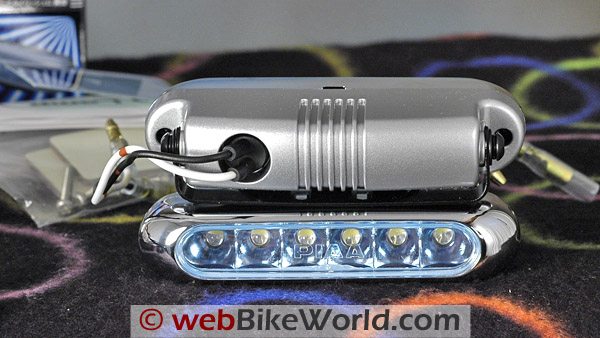
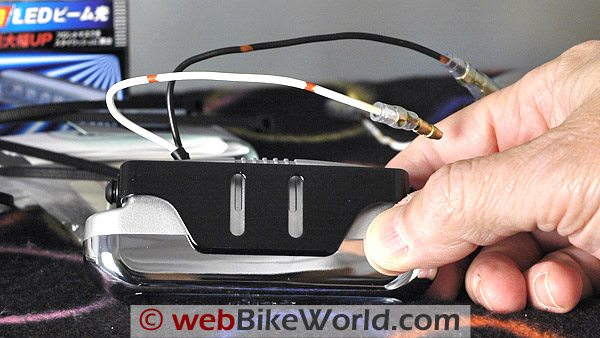
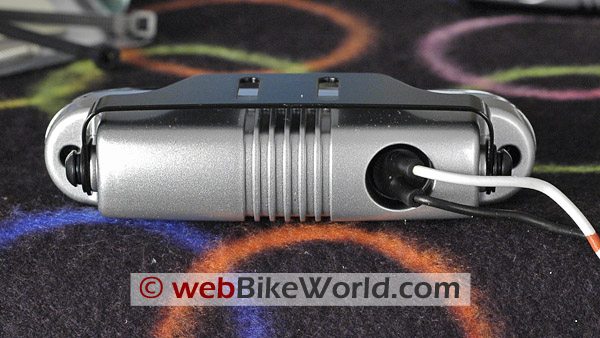
Light Details
I don’t need a lot of light; in fact, for reasons mentioned above, I don’t want the light to be too bright. I found these PIAA LED lights which seemed interesting.
They have 6 LED lights, and regardless of PIAA’s “high intensity” label, these LEDs are not very bright — not even as bright as most of the LED flashlights reviewed on webBikeWorld.
The kit comes with two 6-LED light bars.
They are made from chrome-plated plastic, and they have a flat mounting bracket that rotates from one side to the other, about 180 degrees.
The light modules can be mounted in any orientation.
The mounting brackets use an Allen screw at each end to tighten the light housing once the light is oriented in the desired position. They even provide some extra wire, double-sided tape and the hex wrench.
Splicing the light to the motorcycle’s circuit is easy: white is positive and black is negative (ground). The instructions are minimal and as you can see in the photo at the top of the page, the box is printed mostly in Japanese. The lights are made in Japan.
Uh, and they’re very, very expensive for what they are. Very expensive!
There is no information I can find on the box, the lights, in the instructions or on the PIAA website that tells how much power they use, but LEDs typically use very little, so that shouldn’t be a consideration.
Conclusion
The only problem is that they are an unusual shape for motorcycle use. Each light measures about 100 mm long by 19 mm thick and the body of the light is about 35 mm deep. Each light only weighs 52 grams (1.875 oz.).
I just couldn’t find a place to mount them on any of the bikes around here without having to drill in to something or making them look too obvious.
It’s always very difficult to take photos of lights when they’re on, and these are no exception, as you can see from the photos. Again, they do not throw out any light that can be used to augment a headlight; they are running lights only. Think LED flashlight.
The reflector and lens also broadly diffuses the light — just what you want for a running light actually.
Part 2: PIAA LED Lights Installation
| wBW Review: PIAA LED Lights | |
|---|---|
| Manufacturer: PIAA | List Price (2008): $99.49 per kit. |
| Colors: White light. | Made In: Japan. |
| Review Date: September 2008 | |
| More: Motorcycle Lighting Reviews | Posi-Lock Connector Review | |
Owner Comments and Feedback
See details on submitting comments.
From “M.D.” (9/09): “The reviewer and several respondents all agreed they could see no use for these. I humbly beg to differ!
Neither my Vulcan 750 nor my wife’s Ninja 250 can spare 110 watts of electrical capacity for the 55w incandescent driving lights the “useless” crowd prefer.
These LEDs — and low-current-draw — lights would be just the thing to increase forward visibility on cycles with low-capacity electrical systems.
Thanks for your time, and thanks for the great content! I visit your site often, and find your reviews linked in search results frequently.”
From “D.P.” (3/09): “Regarding the LED driving lights, I have mounted the small PIAA halogen lights to the forks (with one of the fender mounting screws) of my Suzuki V Strom. I’ve had friends and other drivers tell me they can see me a long way down the road.
The constant motion of the forks moving with suspension action and steering makes me much more visible.
My problem is the lights take so much power I can’t run them all the time without running the battery down when riding. Have had a few dead battery no start episodes. The LED with low power draw just might be my answer.”
From “P” (10/08): “I know why you can’t find a use for this product. It’s mostly for “Big Scooter” riders in Japan. Putting PIAA driving lights on your Yamaha Majesty or Honda Forza (Reflex) is all the rage on the Shuto.
Not to mention wild body modifications, lots of chrome and air suspension. It’s the Japanese equivalent of “Mod culture” in Britain a few decades ago.”
From “D.G.” (10/08): “I am in total agreement with ‘Mad Dog’ – can’t think of a single constructive use for the PIAA LED lights. My 55 watt running lights measure 3″ x 5” each yet drivers note they can see me coming at 3/4 mile.
Given their small optical footprint and limited output, why would anyone bother with an LED running light?
One related improvement under consideration for my cruiser are switched, wig-wag running lights. This would provide regular lighting 99% of the time with the option of firing a pair of attention-getting, pulsating lights at potential threats.
This would be ideal for those white knuckle situations where distance limits a horn’s effectiveness. I frequently toggle the Hi/Low headlight back and forth when some bozo is coming head-on in my lane while passing traffic.
Ditto those about to cross in front while turning off or onto the roadway. Something a little more aggressive would be a nice improvement.
So, you ask, why doesn’t he install a modulator instead?
First of all, modulators are notoriously difficult to wire. Second, they are pretty spendy.
Third, for reasons mentioned in other comments, a full time throbbing headlight isn’t always desirable. Finally, the notion of oncoming and crossing traffic thinking I am an emergency vehicle ain’t all bad.
While many of us take precious seconds to process visual signals, wig-wags shout “Uh, oh….Cop!” producing instantaneous awareness and a visceral response from most drivers.
Simply adding a suitable push-button switch and a $20 wig-wag module from EBay will produce that on-demand attention bikers crave without all the downsides of a modulator.”
Editor’s Note: Be sure to check the legality of “wig-wag” lights in your location. Also, check out ourheadlight modulator articles; some of the newer types are relatively easy to install.
From “J.M. de O” (9/08): “I am a Spanish “Ducatista” with a Monster 600 (last carburetor units, 2001) in Red. I bought it from a friend of mine (who wanted to sell it but continue watching once in a while…) with 8 years and 13.000 km. Almost 2 years later, it has 20.000 km…
I’m 33 years old and with a Mechanical Engineer degree (not electrical, but I have done my homework…)
As you probably know, the Monster is well known for been the bike with the best lights (just kidding), so my first issue is to improve lighting. I am doing a HID replacement for the H4 bulb.
Today is a low-beam-only but I hope next week it will be bi-xenon (the seller send me a non-bi-xenon, but the new one is on way right now…)
And now… regarding PIAA LED lights…
Here in Spain a TV channel has “suggested” switching on the light for all the vehicles during the day (and, of course, night).
Bikers associations are against this because today, we (bikers) are the only ones that use the lights. If everyone uses the normal lights, we can become “invisible” (you probably know what I am talking about).
If you need there is a .pdf (or a PowerPoint, I can’t remember) in which an European association gives the clues about it (why to be against).
Regarding the new lights (for example Audi R8 or A4) the main difference is that the shape of the light is completely different to the normal ones (they are long instead of round.
In my opinion, the first thing that you have to ask to those “day lights” is to be completely different to the “normal” one. As the shape is different, this is ok.
And the other is to be placed far from the headlight.
So, the best place could be:
- Bar ends: both in horizontal or vertical (disadvantage for wider bike). Or put them in the “hand guards” (like the blinkers of the Hypermotard).
- Front forks: In vertical position (but too different from normal).
- Front forks: In horizontal position. As the Ducati front wheel axis is hollow, lets place them in horizontal (like some “mushrooms” that are supposed to protect from crashes).”
From “G.S.” (9/08): “For my part, I use the emergency flashers whenever riding in “local” traffic. Happily, they came standard on both my FJR and new Bandit. There is no question drivers now see me!
Minor problem is need to turn them off when using turn signal.
A bit inconvenient, but much less so than an accident. They should be standard equipment on all bikes and mounted above the turn signals – just as Suzuki does.
Can’t comment on the legality of riding with emergency flashers on but I’ll happily go to court to argue the case…”
From “D.S.” (9/08): “I had always considered some sort of lighting setup that would create a “pool of light” that surrounded my bike.
I don’t know if this would hamper my own vision from the saddle during nighttime hours but I thought it would really enhance my visibility to other cars.
Sort of like the neon lights that the guys on Pimp My Ride like to use underneath automobiles. I figured LED lights would be perfect for this sort of use…”
From “M.S.” (9/08): “I agree with you 100% on differentiating yourself from the other vehicles with daytime running lights. Before cars had daytime running lights, motorcycles were required to have headlights on during the day to add conspicuity.
Now that the majority of cars have daytime running lights, the regular headlight is not sufficient. Therefore, I ride with my high beams on during daylight hours. Even though a driver may not see my directional signal due to the bright headlight, at least they do see me.
From (The Motorcycle Council of New South Wales, Australia website):
“Day time headlights may also help but again, only if they make you stand out against the rest of the traffic. In the NZ study, riders with lights on during the day had a 27% lower risk.”
From (How Stuff Works, Vision): (An article on) 1. Depth Perception; 2. Moving Parallax and 3. Stereo vision.
#1 Comments: In daylight, you determine distance by how large the object is. Automobiles all have the same approx. horizontal surface area. Also lends credence to the statement, “I never saw him”.
If you’re not looking for motorcycles, you’re not going to see them. At night, you can’t see the size of the vehicle. Only the taillights/headlights can be seen. This leads to #2
#2 Comments: “Moving Parallax” (when driving at night) can be interpreted as how far apart the headlightstaillights are on the vehicle.
This is how we judge distance at night. If the two headlights are close together, the car is further away.
As the vehicle approaches you, the headlights move further and further apart. However, If only one headlighttaillight is visible – such as on a motorcycle – it’s difficult to judge how far away the vehicle is.
At night a motorcycle’s headlight can appear to be stationary because it never gets significantly bigger until it is very close to you.
#3 Comments: This is only used on objects up to approximately 1 meter away.
From: (An article on depth perception):
“When we look directly at an object, the image falls mostly on the fovea, a tiny portion of the retina.
The brain must compute the three-dimensional structure of reality (width, height, and depth) from an image that is focused on the two-dimensional surface of the retina”
At a distance of 3/4 to 1 mile, all we have to determine distance is width and height. At this distance, a vehicle and bike look vastly different. At this distance, a vehicle’s width can be estimated.
However, a bike’s width is so small, it is very hard to estimate. Anything that can be done to increase the perception of a motorcycle’s width and height will increase it’s conspicuity.
On my Magna, I put the lights on the crash-guards and created a “triangle” of light. Very effective at night (when I primarily used them). I did not intend for them to light up the road, but for drivers to “see me”.
I had mounted them more centered on my bike, where they lit up the fork and front tire, but did not feel they were placed far enough apart to significantly increase my perceptual “horizontal surface area”.
Here is a pic of my 55 watt driving lights mounted on the crash-bars of my ’83 V45 Magna.
For bikes without a place to mount the lights far apart, I recommend mounting them on the lower part of the bike near axle level. This will increase the bike’s perceptual height.
Another advantage is that the light will illuminate the front tire – adding to your side view conspicuity.”


